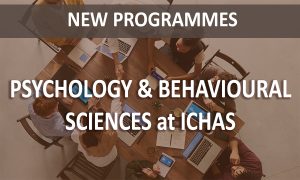
CBT What is it & Why Train in it
Ann Bracken, lecturer in CBT at ICHAS recently talked about how this form of therapy can help counsellors understand and support clients. She also dispelled some of the myths surrounding CBT and how you can integrate it into your therapeutic practice.
We filter our life experiences through what we think about them, forming opinions, self-beliefs, and expressions through what we say and do. This is not always self-serving e.g. if a negative or traumatic experience happens, the individual may infer self-blame or self-shame towards themselves rather than integrating a more compassionate way of understanding and speaking towards themselves.
Equally, with anxiety, there can be a bias in thinking towards ‘catastrophic’ worry’s – fantasy stories in the mind where the feared outcome is based on worst-case scenario thinking. This can lead to the individual seeking constant reassurance from others and being preoccupied with worrying thoughts, finding it difficult to focus on work or daily tasks.
With depression, clients can focus on the past with a ‘regret orientation’ way of perceiving the past and look to the future as being bleak. This leads to feelings of hopelessness and helplessness.
How CBT Works
CBT works collaboratively with the client to understand how these ways of thinking are deepening symptoms of depression or anxiety etc. It works on therapeutic goals with the client to help develop more emotional reasoning, balanced ways of perceiving ourselves and others. This is done within the session and also with the use of specifically focused CBT handouts that the client utilizes between sessions.
CBT explores how the client is thinking towards themselves, others and situations they are in. It also explores the result of unhelpful thinking, self-sabotaging behaviours and self-beliefs – and how they can be instigators in their own change.
CBT Myths
It’s important for therapists to first understand that there are unfounded myths associated with CBT…
Myth One: CBT treats symptoms without focusing on the individual
Naturally, it requires a well-established, trusting, and respectful therapeutic relationship for the client to feel emotionally safe enough to express their issues, symptoms and hopes for therapeutic change. This is the premise of every therapeutic relationship and that includes CBT.
Within that context CBT focuses on areas of change – symptoms and behaviours that the client wishes to change and the CBT therapist and client work together towards supporting specific changes in these areas.
Myth Two: CBT ignores the past
CBT explores past experiences and how they impact on self-belief and relationships in the present. It looks at early relationships and events and what meaning we have taken from it. Does the client not believe in themself because something negative happened to them? Do they think they are unworthy of love because they were mistreated? The focus is then on finding a more self-supportive internal dialogue by working with the client on an alternative way of speaking to themselves and challenging themselves with a different way to respond to triggers. This is explored therapeutically using Socratic questions to understand client assumptions, beliefs, reasoning etc.
Whilst it is helpful to discuss the past and understand how our pasts have influenced our lives and how problems have arisen, CBT mostly focuses on looking for ways to improve individual’s beliefs, relational behaviours and thoughts that may have developed in the past but in the context of how they relate to present day experiences and relationships.
Myth Three: CBT is too rigid and uses too many scientific methods
CBT is considered an ‘evidence-based’ practice in that it integrates protocols and worksheets that have been assessed and proven to be effective, with for example; anxiety, depression, OCD, confidence issues, PTSD, etc.
As such, a therapist will work within a particular therapeutic sequence to target areas of concern – how the client is thinking, what they believe or how they behave when their PTSD or OCD triggers are activated. The client is challenged, but not overwhelmed in this process. This also means that the therapy is very much focused on the client’s therapeutic goals and this is very much part of the weekly therapeutic focus.
The Lecturer
 Ann Bracken, MA, Grad.Dip. PG Cert. PG Dip. draws on her experience and qualifications as a Cognitive Behavioural Psychotherapist, Mindfulness-Based Counsellor, Trauma Therapist and Mind-Body Psychotherapist to inform her approach to training in CBT.
Ann Bracken, MA, Grad.Dip. PG Cert. PG Dip. draws on her experience and qualifications as a Cognitive Behavioural Psychotherapist, Mindfulness-Based Counsellor, Trauma Therapist and Mind-Body Psychotherapist to inform her approach to training in CBT.
Ann is trained in and has experience of working with non-directive and directive forms of counselling psychotherapy. She has worked in clinical settings; in Manchester Centre for CBT, Whythenshawe Hospital, Manchester and The Lister Hospital, London. She has (past and present) lectured for third level and college settings (ICHAS, Glendwr Uni. IADT) in addition to running a private practice (online and in-person).























